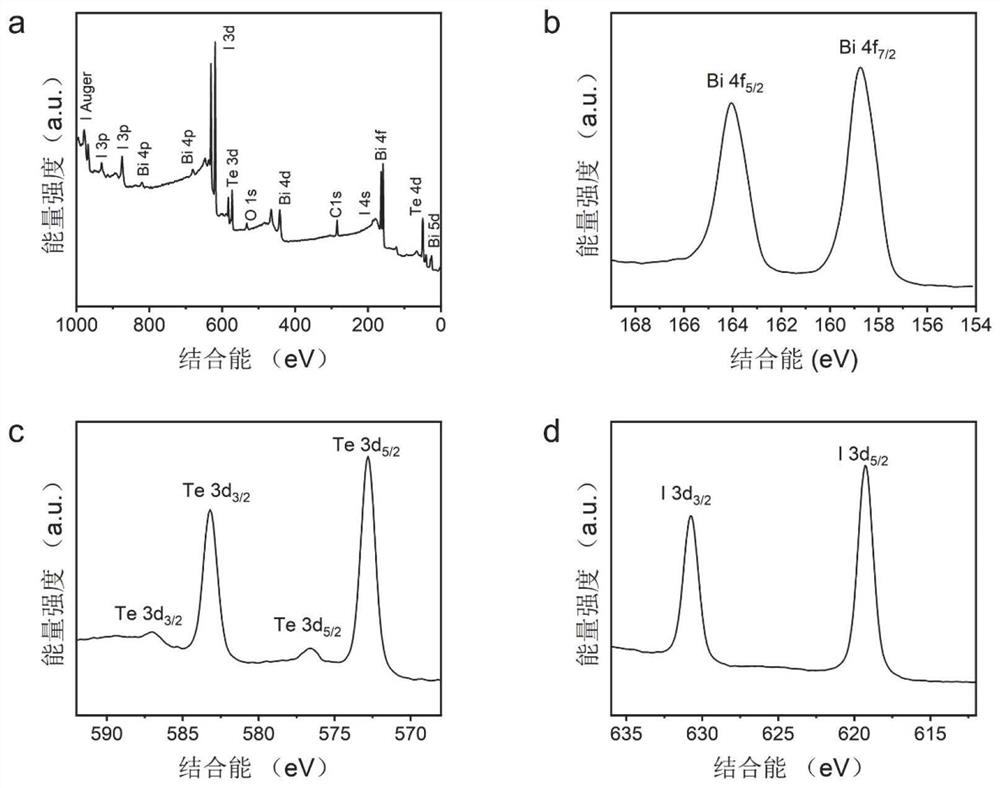Solid-phase synthesis method of narrow-band gap semiconductor MTeI
A solid-phase synthesis and semiconductor technology, applied in chemical instruments and methods, selenium/tellurium compounds, inorganic chemistry, etc., can solve problems such as synthesis hindering development, achieve good practical prospects, shorten synthesis time, and facilitate operation
- Summary
- Abstract
- Description
- Claims
- Application Information
AI Technical Summary
Problems solved by technology
Method used
Image
Examples
preparation example Construction
[0022] The invention provides a solid phase synthesis method of narrow bandgap semiconductor MTeI, comprising the following steps:
[0023] The metal M element, Te element and excess I 2 The simple substance undergoes a solid-state reaction under vacuum conditions to obtain a narrow bandgap semiconductor MTeI;
[0024] M is Bi and / or Sb.
[0025] In the present invention, the excess I 2 Simple substance refers to the calculation of stoichiometric ratio, a slight excess but not more than 1.2 times I 2 Simple substance.
[0026] In the present invention, the metal M element, Te element and excess I 2 The simple substance is placed in the quartz tube, and the quartz tube is sealed while maintaining the vacuum state in the tube, and the sealed quartz tube is placed obliquely in the muffle furnace, and the reactants are kept at the bottom of the quartz tube.
[0027] Then make the muffle furnace heat up to temperature T, then keep the temperature for 20 hours, and finish the r...
Embodiment 1
[0036] Get 0.5mmol bismuth [Bi] elemental powder, 0.5mmol tellurium [Te] elemental powder and slightly more than 0.25mmol iodine elemental [I 2 ] in a quartz tube with an inner diameter of 8mm, and seal the quartz tube while maintaining the vacuum inside the tube. Place the sealed quartz tube obliquely in the muffle furnace to keep the reactant at the bottom of the quartz tube. After a certain period of time, the muffle furnace is heated to about 500°C, and kept at this temperature for 20 hours. After the reaction, the muffle furnace was naturally cooled to room temperature, and a bulk solid BiTeI product with metallic luster was obtained.
[0037] The morphology, structure, phase and composition of the BiTeI product are characterized as follows:
[0038] BiTeI belongs to the P3m1 space group, and its X-ray diffraction pattern (XRD) is as follows figure 1 As shown in a, among them, at 12.932°, 23.675°, 26.033°, 27.067°, 35.474°, 39.492°, 41.624°, 43.768°, 46.563°, 50.358°, ...
Embodiment 2
[0045] Get the same amount of 0.5mmol bismuth [Bi] elemental powder as in Example 1, 0.5mmol tellurium [Te] elemental powder and slightly more than 0.25mmol iodine elemental [I 2 ] in a quartz tube with an inner diameter of 8mm, and seal the quartz tube while maintaining the vacuum inside the tube. Place the sealed quartz tube obliquely in the muffle furnace to keep the reactant at the bottom of the quartz tube. After a certain period of time, the temperature of the muffle furnace is raised to 550°C, and it is kept at this temperature for 20 hours. After the reaction, the muffle furnace was naturally cooled to room temperature, and a bulk solid BiTeI product with metallic luster was obtained. Figure 5 It is the X-ray diffraction pattern (XRD) and scanning electron micrograph (SEM) of the BiTeI prepared in Example 2. All the diffraction peak positions in the XRD can match the crystal planes of BiTeI, indicating that at a temperature of 550 ° C, still A pure narrow bandgap se...
PUM
 Login to View More
Login to View More Abstract
Description
Claims
Application Information
 Login to View More
Login to View More - R&D
- Intellectual Property
- Life Sciences
- Materials
- Tech Scout
- Unparalleled Data Quality
- Higher Quality Content
- 60% Fewer Hallucinations
Browse by: Latest US Patents, China's latest patents, Technical Efficacy Thesaurus, Application Domain, Technology Topic, Popular Technical Reports.
© 2025 PatSnap. All rights reserved.Legal|Privacy policy|Modern Slavery Act Transparency Statement|Sitemap|About US| Contact US: help@patsnap.com



